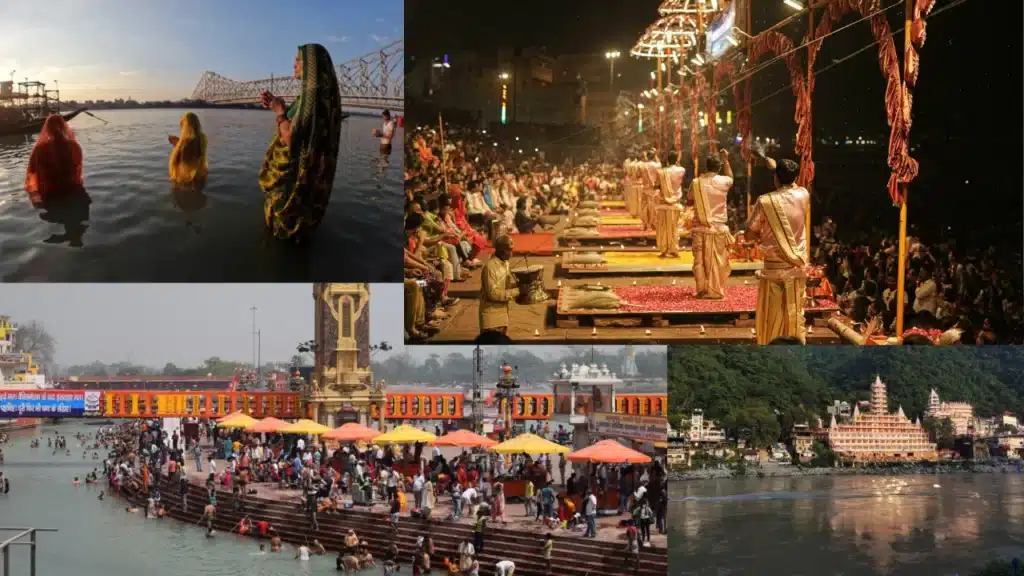Ganga Dussehra 2025 will be celebrated on June 5. This Hindu festival Honors the Arrival of Maa Ganga to earth and is celebrated with great devotion in the cities like Varanasi, Haridwar, Rishikesh, Prayagraj and Garhmukteshwar.
This festival is also known as Gangavataran, which is believed to symbolize the spiritual purification connected with the arrival of Ganga.
Ganga Dussehra 2025 Date
- Date: Thursday, 5 June 2025
- Tithi: Dashami, Shukla Paksha, Jyeshtha month
Ganga Dussehra 2025 Muhurat
- Dashami Tithi Begins: 11:54 PM on Jun 04
- Dashami Tithi Ends: 02:15 AM on Jun 06
- Hasta Nakshatra Begins: 03:35 AM on Jun 05
- Hasta Nakshatra Ends: 06:34 AM on Jun 06
- Vyatipata Yoga Begins: 09:14 AM on Jun 05
- Vyatipata Yoga Ends: 10:13 AM on Jun 06
Ganga Snan Time
The most auspicious time (Shubh Muhurat) for bathing on Ganga Dussehra is from 5:25 am to 7:40 am. This time is considered especially pure. If it is not possible to bathe during this time, then one can bathe with Gangajal at any time throughout the day.
Taking a dip in the river Ganga 5 or 7 times is considered auspicious on this day. Along with this, Pouring Gangajal on the Shivling is also fruitful. Hasta Nakshatra is especially important on Ganga Dussehra, which further increases the special virtue of this day.

Spiritual Significance of Ganga Dussehra
“Dussehra” means the destruction of ten sins that have been committed through thoughts, words and deeds. Ganga Dussehra honors the efforts of King Bhagirath to bring Ganga to earth to purify the souls of his ancestors. Taking a dip in the holy Ganga on this day washes away the karmic impurities of a lifetime.
Ganga Dussehra Puja Vidhi (Worship Method)
On this day people wake up early in the morning and take a bath. If they cannot go to the Ganga river, they take a bath at home by mixing Gangajal in normal water. After bathing, people worship the photo or idol of Maa Ganga. They offer flowers, incense, diya and bhog (food) in the puja. Mantra (Om Namo Gangaye Vishwarupiniye Narayanye Namo Namah) is chanted while performing the puja. At the end of the puja, Ganga Aarti is performed and then the prasad is distributed among the people.
Major Places of Celebration
- Varanasi: Here devotees perform Ganga Aarti and bathe in the Ganga
- Haridwar & Rishikesh: Known for grand spiritual rituals
- Prayagraj: confluence (Sangam) of Ganga, Yamuna, and Saraswati
- Garhmukteshwar: Known for peaceful celebrations and local gatherings.
How Did Goddess Ganga Descend to Earth?
According to Hinduism, Goddess Ganga originally resided at the feet of Lord Vishnu. When King Bhagiratha performed intense penance to liberate the souls of his ancestors, Lord Shiva accepted his prayer and released Ganga from the heavens through his matted hair (jata) to soften her mighty flow.
To control the stream of the river, Lord Shiva split her into seven streams and those are Nalini, Hridini, Pavani, Sita, Chakshush, Sindhu, and Bhagirathi. Among them, the stream of Bhagirathi became the river which we now call Ganga river, the giver of moksha (liberation).
Some beliefs also consider Goddess Ganga to be the sister of Goddess Parvati, and even today, it is said that Ganga continues to dwell in the locks of Lord Shiva.
